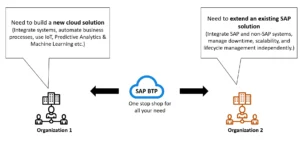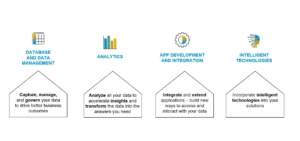Are you looking to take your business to the next level by leveraging cutting-edge technology and seamless integration? If so, you’ve come to the right place. In this beginner’s guide, we will introduce you to the SAP Business Technology Platform (SAP BTP) and explore how it can transform your business operations. We’ll also talk about its integration with SAP S/4HANA and the value of consulting services.
What is SAP Business Technology Platform?
SAP BTP is a robust and comprehensive platform that empowers businesses to innovate, integrate, and extend their applications with ease. It provides a unified and open environment for developing and deploying applications and services. Let’s dive into its key components:
Let’s try to understand SAP BTP using 2 example scenarios given in one of the SAP blogs itself:
Scenario 1
Whether you’re an existing SAP client or a new entrant to the SAP ecosystem, there’s an organization that wants to create a cloud or mobile solution. Within this solution, you’ll need to connect multiple systems, streamline complex business operations, and integrate modern technologies (i.e. Internet of Things, Predictive Analytics, Machine Learning, etc.).
Scenario 2
An organization (whether it’s an existing SAP customer or not) wants to create a cloud-based solution to expand its existing SAP systems (like S/4Hana or SuccessFactors). They need services to make sure everything runs smoothly between systems and applications, and they need to be able to manage downtime, scalability, and lifecycle management independently.
In both cases, the goal is to build the solution in a way that is effortless, cost-effective, and time-effective. Organizations don’t want to spend time and money on landscape setup, system setup, configuration, and maintenance.
Source: https://blogs.sap.com/
SAP BTP is a suite of services and solutions from SAP that meet all these needs. The SAP BTP portfolio is a collection of SAP services and solutions that are bundled together. These services and solutions help organizations create a new cloud-based solution or extend existing SAP systems.
History
In the early days of SAP BTP, the company was known as SAP Hana Cloud Platform. Later on, the company changed its name to SAP Cloud Platform. The goal of SAP Cloud Platform was to offer a platform that was not only SAP HANA-related but also related to other open-source tools and services, such as Java development and MongoDB.
SAP thrives on real-world industry business processes, which is why the name was finally re-named SAP Business Technology Platform. This suggests that SAP BTP is focused on business requirements, using a variety of technologies, including, of course, open-source ones.
Initially, SAP offered an infrastructure level, which we refer to as “NEO,” which is the historical version. More recently, SAP has moved this level to partners, such as AWS, Azure, Google Cloud Platform (GCP), or Alicloud, and we refer to this level as “CF,” short for Cloud Foundry, which is the current version. In a way, this shift reflects SAP’s change in strategy due to the rapid growth of the digital world.
SAP BTP has so far been associated with a very solid architecture that is easily expandable, both from the customer and the SAP point of view. We know that SAP BTP as a platform has no value at all, while the top 90+ services are essential for real enterprise day-to-day use.
Source: https://blogs.sap.com/
Benefits of SAP BTP
By adopting the SAP Business Technology Platform (SAP BTP), organizations can unlock several transformative benefits, as it allows them to leverage the power of this integrated suite of tools and services. SAP BTP is a versatile and comprehensive solution that facilitates various aspects of digital transformation.
Here are some key advantages:
Agility and Flexibility
SAP BTP with SAP S/4HANA: Integration with SAP S/4HANA enables real-time insights and faster decision-making.
Scalability: Easy scalability of applications and infrastructure to meet evolving business needs and market demands.
Adaptability: Swiftly adapts to changing market conditions and customer preferences, ensuring business resilience.
Integration and Connectivity
Seamless Integration: SAP BTP provides seamless integration capabilities for systems, applications, and data sources.
Collaboration: Foster improved collaboration among teams and departments through synchronized processes and data.
Automation: Automate business processes for increased efficiency and reduced manual effort.
Data Consistency: Ensure data consistency across the organization, reducing errors and data silos.
Innovation and Customization
Extension Suite: Empower organizations to innovate by extending and customizing SAP applications to align with unique business requirements.
Accelerated Time-to-Value: Rapid development and deployment of tailored solutions lead to quicker realization of benefits.
Enhanced Data Insights
Analytics Suite: Harness the power of advanced analytics and reporting tools to gain actionable insights from data.
Data-Driven Decision-Making: Enable data-driven decision-making, optimizing operational efficiency and customer experiences.
Future-Readiness
Intelligent Technologies: Leverage intelligent technologies like AI, machine learning, and IoT to future-proof your business.
Competitive Edge: Stay ahead of industry trends, capitalize on emerging technologies, and drive continuous innovation.
SAP Consulting Services: Seek guidance and expertise from SAP consulting services to fully leverage SAP BTP’s potential and align it with your strategic goals.
Four Key Pillars of SAP BTP
SAP BTP services and solutions fall under four main pillars:
- Database & Data Management
- Analytics
- Application Development & Integration
- Intelligent Technologies
Source: https://blogs.sap.com/
Let’s take a closer look at each one:
Database & Data Management
This foundational pillar encompasses all the necessary components for the storage, retrieval, processing, integration, and interpretation of critical data within an organization.
Within this pillar, a range of services and products is available to efficiently and flexibly manage data at high speeds. Notably, SAP HANA Cloud stands out as a central service, offering potent and adaptable data management capabilities through an in-memory database hosted in the cloud.
Moreover, SAP Datasphere plays a pivotal role in providing a unified perspective of data across the entire organization, eliminating the need to physically consolidate it into a single location. Complementing these offerings, other services within this pillar include SAP Data Intelligence, SAP Data Services, SAP Master Data Governance, and more.
Analytics
The offerings within the analytics pillar empower us to strategize, predict, and swiftly make informed decisions based on insights.
As an illustration, SAP Analytics Cloud serves as a powerful tool for consolidating data from various sources, including operational systems, data warehouses, and . It can seamlessly integrate external market data or third-party spreadsheets, leveraging machine learning capabilities. This enables automatic detection of anomalies, accurate forecasting, and the creation of intelligent scenario-planning solutions.
Application Development and Integration
The application development and integration pillar equips us with the essential tools to construct cloud-based solutions, seamlessly integrate SAP and non-SAP systems and solutions, and extend existing SAP solutions.
For instance, imagine a scenario where we need to retrieve data from SAP S/4HANA, incorporate additional business logic, amalgamate information from third-party systems, and ultimately create a Fiori app or mobile application. Within this pillar, SAP Business Technology Platform (SAP BTP) offers a suite of services such as SAP Business Application Studio, SAP Build, SAP Integration Suite, and more. These services comprehensively address the demands of such requirements, providing robust support.
Intelligent Technologies
Within the realm of intelligent technologies, this pillar encompasses a range of services that simplify the integration of cutting-edge capabilities such as artificial intelligence, machine learning, intelligent robotic process automation, blockchain, and the Internet of Things (IoT) into our solutions on the SAP Business Technology Platform (BTP).
What sets SAP BTP apart from other platforms?
SAP BTP distinguishes itself by offering three significant advantages that make it a unique and exceptional solution for organizations.
Unified:
SAP BTP stands out by providing a unified experience that caters to a diverse range of scenarios related to integration, data-driven value creation, and process extensibility across 25 key industries. Its capabilities support a simplified user interface and foster functional interoperability between SAP applications and technology.
Business-Centric:
SAP BTP is purpose-built for driving business transformation, prioritizing outcomes over mere technological optimization. Its features are laser-focused on enhancing the business results that companies can attain. The platform offers specialized tools for both processes and data, enabling organizations to rapidly develop and expand SAP applications. Business services and prepackaged content are available to assist users in meeting domain-specific requirements and crafting targeted data analysis scenarios.
Open:
Recognizing the need for flexibility in deploying and running business processes and IT systems, SAP BTP’s open nature allows organizations to choose their preferred deployment method. Whether on a hyper-scale cloud infrastructure, in SAP data centers or on their own premises, SAP BTP provides the freedom to tailor the solution to their unique needs.
Conclusion
I trust that this blog has provided you with a comprehensive understanding of SAP BTP. With SAP BTP, businesses can seamlessly integrate, analyze, and extend their operations, enhancing their agility, competitiveness, and overall success. It’s a powerful tool that empowers organizations to unlock new possibilities and navigate the ever-evolving digital world with confidence.








